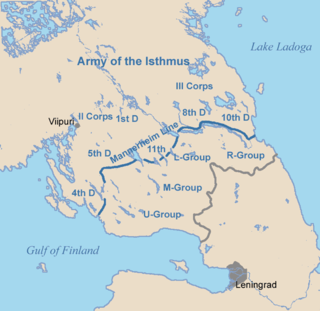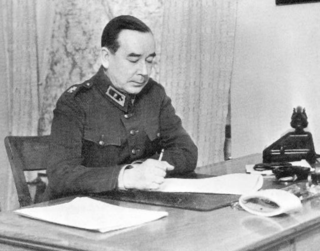
Hjalmar Fridolf Siilasvuo was a Finnish lieutenant general, a knight of the Mannerheim Cross and a member of the Jäger Movement. He participated in the Eastern Front of World War I, the Finnish Civil War, the Winter War, Continuation War and the Lapland War.

The Finnish Army is the land forces branch of the Finnish Defence Forces. The Finnish Army is divided into six branches: the infantry, field artillery, anti-aircraft artillery, engineers, signals, and materiel troops. The commander of the Finnish Army since 1 January 2022 is Lieutenant General Pasi Välimäki.

Karl Lennart Oesch was one of Finland's leading generals during World War II. He held a string of high staff assignments and front commands, and at the end of the Continuation War commanded three Finnish army corps on the Karelian Isthmus. He received numerous awards, including the Finnish Mannerheim Cross during his service. Following the end of the Continuation War, he was tried and convicted for war crimes relating to the treatment of Soviet prisoners-of-war.

The 49th Infantry Division was an infantry division of the British Army. The division fought in the First World War in the trenches of the Western Front, in the fields of France and Flanders. During the Second World War, the division fought in the Norwegian Campaign and in North-western Europe. After the Second World War, it was disbanded in 1946, then reformed in 1947. It remained with Northern Command until finally disbanded in 1967.

The 4th Infantry Division was a regular infantry division of the British Army with a very long history, seeing active service in the Peninsular War, the Crimean War, the First World War, and during the Second World War. It was disbanded after the war and reformed in the 1950s as an armoured formation before being disbanded and reformed again and finally disbanded on 1 January 2012.

The 5th Infantry Division was a regular army infantry division of the British Army. It was established by Arthur Wellesley, 1st Duke of Wellington for service in the Peninsular War, as part of the Anglo-Portuguese Army, and was active for most of the period since, including the First World War and the Second World War and was disbanded soon after. The division was reformed in 1995 as an administrative division covering Wales and the English regions of West Midlands, East Midlands and East. Its headquarters were in Shrewsbury. It was disbanded on 1 April 2012.

The Battle of Honkaniemi was fought between Finnish and Soviet forces on 26 February 1940. This battle was notable for being fought by tanks, the only time they were used en masse in combat by Finnish forces in the Winter War.

The Battle of Narva was a World War II military campaign, lasting from 2 February to 10 August 1944, in which the German Army Detachment "Narwa" and the Soviet Leningrad Front fought for possession of the strategically important Narva Isthmus.

The Army of the Isthmus was a formation of the Finnish Army during the Winter War. It was stationed on the Karelian Isthmus and was the largest formation of the Finnish Army, as it was charged to defend the important isthmus.
The IV Corps was a formation of the Finnish Army during the Winter War against the Soviet Union. It defended the area north of Lake Ladoga against Soviet attacks. It was commanded by Major General Juho Heiskanen and from 4 December 1939 by Major General Woldemar Hägglund. The IV Corps defeated superior Soviet troops by using motti tactics.
The III Corps was a unit of the Finnish Army during the Winter War. The III Corps with the II Corps formed the Army of the Isthmus. For most of the war it defended the Mannerheim Line on the northern side of the River Vuoksi against Soviet attacks.

The 29th Infantry Brigade was an infantry brigade unit of the British Army. It was originally raised in 1914 and saw service during the First and Second World Wars and the Korean War.

The 227th Infantry Division named "Rheinisch-Westfälische" was created on 26 August 1939 in Krefeld. The division was deployed for the last time in February 1945 in the Tuchola Forest.

Johan Woldemar Hägglund was a Finnish lieutenant general in the Finnish Army in the Second World War, and an early volunteer of the Jäger Movement. He participated in the Eastern Front of World War I, the Finnish Civil War, the Winter War and the Continuation War, commanding army corps in the latter two. Between 1944 and 1945, he was in charge of a committee investigating Finnish war crimes, especially those committed against prisoners-of-war.
Foreign support in the Winter War consisted of materiel, men and moral support to the Finnish struggle against the Soviet Union in the Winter War. World opinion at large supported the Finnish cause. The Second World War had not yet begun in earnest and was known to the public as the Phoney War; at that time, the Winter War saw the only real fighting in Europe besides the German and Soviet invasion of Poland, and thus held major world interest. The Soviet aggression was generally deemed unjustified. Various foreign organizations sent material aid, such as medical supplies. Finnish immigrants in the United States and Canada returned home, and many volunteers traveled to Finland to join Finland's forces: 8,700 Swedes, 1,010 Danes, about 1,000 Estonians, 850 Ukrainians, 725 Norwegians, 372 Ingrians, 366 Hungarians, 346 Finnish expatriates, more than 20 Latvians and 190 volunteers of other nationalities made it to Finland before the war was over.

Harald Öhquist was a Finnish Jäger and Lieutenant General during World War II.

Hannu Esa Hannuksela was a Finnish Major General during World War II.

The 18th Rifle Division was an infantry division of the Soviet Union's Red Army during the Russian Civil War, Polish–Soviet War, Winter War and World War II. The division was formed a total of five times during this period.
The 49th Rifle Division was a Soviet Army infantry division, formed three times. First formed as a territorial division in 1931, the 49th Rifle Division's first formation became a regular division by 1939 and fought in the Winter War. For its actions during the war, it was awarded the Order of the Red Banner. However, the 49th Rifle Division was wiped out during the first ten days of Operation Barbarossa. Its second formation occurred in December 1941 and fought at Stalingrad, Kursk, the Vistula-Oder Offensive and the Battle of Berlin. The second formation was disbanded in 1946. The division was reformed in 1955 by renaming the 295th Rifle Division and became the 49th Motor Rifle Division in 1957.

Aarne Leopold Blick was a Finnish lieutenant general, Knight of the Mannerheim Cross and a member of the Jäger movement. He participated in the Eastern Front of World War I, the Finnish Civil War, the Winter War and the Continuation War.















